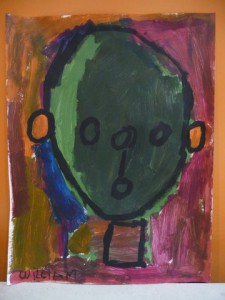Reflection by Anne Chabert d’Hières
Artist : William Aknin
Title : ‘Face’
Edited article from NEWSLETTER L’ARCHE PARIS, JUNE 2011 No.21.
AMATEUR ARTISTS… AND ART LOVERS
Does L’Arche Paris have any artists in its ranks? Does everyone with a talent for artistic expression become an artist? Can works which are sensitive and impressive in an assisted living setting be seen as meaningful by the world of art?
For as long as anyone can remember, the L’Arche Paris Studio has offered a range of artistic activities. For those people who give themselves over to them, they are powerful vehicles for self-expression and liberation. A focus common to several of these activities is the invitation to use the imagination, engage in the creative act, and explore aesthetics. We can measure their value in terms of the joy experienced and the progress made by the people taking part in our painting, sculpture, music, photography, dance and other workshops… Based on this evidence, the educational, and even therapeutic, impact of the artistic disciplines is incontrovertible.
But whether we can go so far as to talk about works of art is a matter that still requires much thought. It is vital to set the bar high before declaring that this or that person is an artist. Indeed, if our aim is to give viewers other than family members and institutions the chance to experience the sensitivity of works produced by people who have tended to be marginalized by their disabilities, then naive over-hastiness on our part could have the very opposite effect to that we seek.
In the course of our reflections, we have had the opportunity to listen to Philippe Hélénon, the painter and art therapist, talking about his extensive experience of accompanying troubled teenagers in his studio:
“I’ve seen works that deserved a place in contemporary art… But I’ve always resisted the urge to set their creators up with private viewings, simply because I thought it would be a good idea. If a painter sees his or her own work and wants to make it known, then it’s the therapist’s job to make sure that putting on an exhibition won’t monopolise the artist’s work.
An artist is someone who disrupts. Someone who forces people to think outside the box. An artist is only recognized once the public have managed to integrate his or her new input. Artists make connections that other people don’t. Some works by people with disabilities can be accessed directly. But in our society, artists engage in a discourse, a process. People with disabilities don’t explain their work in the same way. If a third party, like you, takes on this discourse, they can end up committing a burglary or a theft. There’s also a danger that they’ll re-assign the work to another category, and distance the creator from his or her own field.”
The message is clear, namely that before planning an exhibition or a performance, we must adopt a respectful attitude and make every effort to build on the wishes of the people we accompany. We should follow their lead!
And Angeline Brassens is a prime example. She is one of those people who spur us on to take the artistic process further – to give more time and space to her pictorial work, talking about it, presenting it, and exhibiting it… At our 2013 auction, which was sponsored by Jean-Charles de Castelbajac and the Drouot Auction House, and was dedicated to works of art, wines and spirits, she was able to witness the sale of one of her paintings, “Expression of Autumn”, alongside works by well-known artists. Her pride was evident and richly deserved.
To conclude these remarks, here is the transcript of a conversation between plastic artists during a visit to the L’Arche Paris Studio by the sculptor, Jonathan Hirschfeld, and his wife, Mariana. William Aknin, a person with disability, acted as their guide, and showed them a sculpture to which he had given the title: Jo Dassin.
- How have you done this?
W: With plasters.
— Where did you get your inspiration?
W: We went to see the Beaubourg.
— Did your inspiration come from Nicky de Saint-Phalle?
W: Yes. I did that, with my imagination. It’s a pretend guitar.
— Next time, you could make an arm, to go on top.
W: Oh yeah?
— With your drawings, you could draw and imagine the shoulders and then create the volume. Can you paint?
W: No. A little bit.
— You can use the bit you know about painting to prepare your sculptures. Can you see how your sculpture changes when you turn it? Depending on the angle you’re looking from, there are masses of paintings in your sculpture.
W: Ah, okay. It’s beautiful, eh!
Anne Chabert d’Hières
Anne Chabert d’Hières leads the Inclusion project for L’Arche International, and is the French speaking copywriter in the International Communication Team. She gives a voice to people with learning difficulties in different documentaries and media project, like “L’épreuve des mots”. She is a member of L’Arche Paris, France, since the late seventies. She leads formation and training sessions in her community, in “L’Arche en France” and outside L’Arche. She has been an editor at “Fleurus Publishing”, and a freelance editor.

